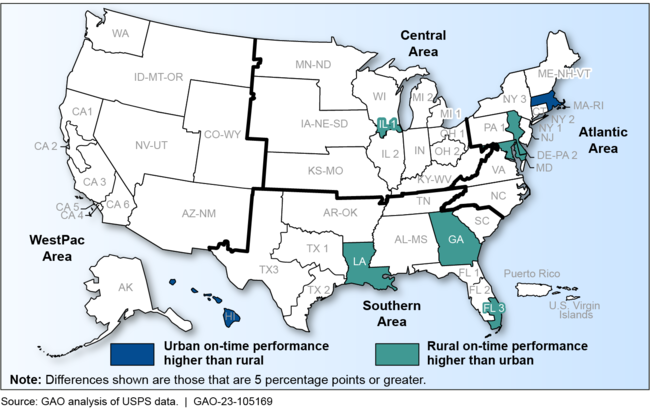“Neither snow, nor rain, nor heat, nor gloom of night” — while the United States Postal Service (USPS) has no official motto, this well-known refrain reflects a key aspect of the organization’s operations: the universal service obligation (USO).
The USO is not contained in any one document, but has been defined through multiple statutes over the course of the past century. It outlines that the USPS is obligated to provide the American public with trusted, affordable, and universal service across multiple dimensions — including geography. Rural free delivery of mail by the USPS became a permanent service in July 1902. Today, despite being home to 16% of the US population, rural areas comprise 88% of the area served by the Postal Service, and 57% of post offices are in rural areas.
A majority of rural Americans appreciate these efforts: According to the United States Postal Service Office of Inspector General (USPS OIG), which tracks nationwide postal performance, 81% of rural postal customers view the Postal Service as valuable. However, the USPS faces multiple financial challenges, leading to initiatives like reduced work hours for rural mail carriers and route optimization. Although these changes are meant to cut costs, they also impact the USO — which USPS OIG has called to reevaluate.
How has the USPS performed in recent years?
On-time performance has improved in the past several years, recovering from lows recorded both before and during the pandemic. Three-to-five day delivery of first-class single piece mail — including letters, postcards, flat envelopes, and small packages — has improved from 54.6% on-time delivery during Q1 2021 to 86.2% in Q3 2023. Marketing mail — one of the Postal Service’s most-used service types by volume — has also improved its end-to-end performance from 59.8% on-time delivery in Q2 2018 to 95.9% in Q3 2023.
In 2022, the USPS delivered a daily average of 421.4 million mail pieces to 164.9 million possible addresses using a variety of types of service. While the volume of mail is decreasing, the number of delivery points is increasing. Between 2011 and 2021, rural delivery points increased by 19%. This is particularly true in the South and West, where some states are adding addresses at more than double the national average.
More recently, USPS OIG reported a quarter-over-quarter improvement in “on-time” performance for all eight measured USPS service types in the third quarter of 2023.
Rural vs. urban on-time mail performance
According to a report from the Government Accountability Office (GAO), USPS performance is also showing progress in rural areas. Rural on-time performance was higher than urban delivery in Georgia, Louisiana, Florida, Maryland, Delaware, eastern Pennsylvania, and northern Illinois between October 2020 through December 2021, with GAO finding “few differences in on-time delivery between rural and urban areas” for the four largest USPS mail products by volume: first-class mail, marketing mail, periodicals, and most packages.
In some postal districts, rural service is better than urban service, as this map from the GAO illustrates.

How do changes to postal services impact rural communities?
The USPS employs an estimated 626,060 people — a 22% decrease from 2005. According to the Department of the Treasury, the majority of these are field employees, serving local communities. Many of these employees work in nonmetropolitan areas, which are defined by the Census Bureau as portions of the country that include no urban areas of 50,000 or more inhabitants.
In some nonmetropolitan areas, USPS mail carriers represent a higher share of employment than average. For example, the North Missouri nonmetropolitan area has 2.6 times more Postal Service mail carriers than the national average, according to Bureau of Labor Statistics location quotient calculations.
Beyond job creation, the USPS has other impacts on rural communities. For example, it is a key component of the US healthcare infrastructure. The Department of Veterans Affairs provides approximately 80% of all outpatient prescriptions to veterans via mail, and over 330,000 veterans receive a package of prescriptions in the mail every day. Currently, 4.4 million veterans reside in rural communities.
Both the GAO and the USPS OIG conclude that, despite recent improvements, the broader challenges facing the Postal Service still present several challenges to rural postal customers.
Explore key facts about the American populace, read more about the United States Postal Service, and get the latest data by signing up for our newsletter.
Keep exploring
Page sources and methodology
All of the data on the page was sourced directly from government agencies. The analysis and final review was performed by USAFacts.
United States Postal Service Office of Inspector General
Service Performance
Government Accountability Office
U.S. Postal Service: Few Differences in On-Time Performance between Rural and Urban Areas

